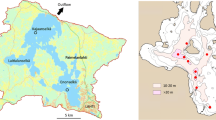Abstract
Lake Ladoga (the largest lake in Europe) was characterized by good water quality some decades ago. Now as a result of human impact, the saprobity and toxicity of water have changed, phytoplankton biomass has increased, and populations of many sensitive species have declined. Morphological deformities of invertebrates are observed in heavily polluted areas and toxic effects are commonly encountered in fishes. The ecological crisis of Lake Ladoga is caused by human activities in its drainage area. This area is characterized by a relatively high degree of industrialization and economic development. The adverse environmental effects appear to be spatially irregular, occurring mostly in isolated bays and near-shore areas, especially when thermal bars are present, but there is also evidence of general increase of nutrient concentrations in the entire lake. Urgent measures should be taken for restoration of Lake Ladoga ecosystem.
Similar content being viewed by others
References
Alekin, A. A., 1967. Gidrokhimia i gidrooptika Ladozhskogo ozera. Nauka, Leningrad. [Hydrochemistry and hydro-optics of Lake Ladoga. In Russian].
Andreyev, A. P., 1875. Ladozhskoe ozero, 1. St. Petersburg, 27 pp. [Lake Ladoga. In Russian].
Chapra, S. C. & N. C. Sonzogni, 1970. Great Lakes total phosphorus budget for the mid 1970's. J. War. Pollut. Cont. Fed. 51: 2524–2533.
Ikonnikov, V. V., 1990. Problema toksichnogo zagrjaznenia Ladozhskogo ozera. In G. M. Voropaeva (ed.), Puti sovershenstvovanija prirodo-polzovanija v basseinach bolshich ozer. Nauka, Leningrad: 34–53. [The problem of toxic pollution of Ladoga Lake. In Russian].
Kalesnik, S. V. (ed.), 1968. Biologicheskie resursy Ladozhskogo ozera (zoologiya). Nauka, Leningrad, 228 pp. [Biological resources of Lake Ladoga. In Russian].
Malinina, T. I. (ed.), 1966. Gidrologicheskiy rezhim i vodniy balans Ladozhskogo ozera. Izd. LGU, Leningrad. [Hydrological regime and water balance in Lake Ladoga. In Russian].
Molchanov, I. V., 1945. Ladozhskoe ozero. Nauka, Moscow - Leningrad, 557 pp. [Lake Ladoga. In Russian].
Official statistics, 1986. Narodnoe chozaistwo Leningrada i Leningradskii oblasti v XI pjatiletke. Leningrad, 230 pp. [Economy of Leningrad and Leningrad district in 1980-1985. In Russian].
Petrova, N. A. (ed.), 1982. Antropogennoe evtrofirovanie Ladozhskogo ozera. Nauka, Leningrad, 304 pp. [Anthropogenic eutrophication of Lake Ladoga. In Russian].
Petrova, N. A. & G. F. Raspletina (eds), 1987. Sovremennoye sostoyanie ekosistemy Ladozhskogo ozera. Nauka, Leningrad, 213 pp. [Present state of Lake Ladoga ecosystem. In Russian].
Petrova, N. A. & A. Yu. Terzhevik (eds), 1992. Ladozhskogo ozero — kriterii sostoyaniya ekosistemy. Nauka, St. Petersburg, 328 pp. [Lake Ladoga — criteria of ecosystem state. In Russian].
Raspletina, G. F., 1982. Regim biogennich elementov. In N. A. Petrova (ed.), Antropogennoe evtrophirovanie Ladozhskogo ozera. Nauka, Leningrad: 79–101. [The regime of biogenic components. In Russian].
Raspletina, G. F. & B. L. Gusakov, 1982. Primenenie prjamogo i kosvennogo metodov dlya rascheta biogennoi nagruski i konzentrazii veshchestv v vode Ladozhskogo ozera. In N. A. Petrova (ed.), Antropogennoe evtrophirovanie Ladozhskogo ozera. Nauka, Leningrad: 222–242. [The use of direct and indirect methods for assessment of biogenic load and concentration of substances in Lake Ladoga water. In Russian].
Raspletina, G. F., E. B. Murashova, T. M. Tregubova, T. P. Kulish & O. A. Chernykh, 1987. Gidrokhimicheskaya kharakteristika pritokov. In N. A. Petrova & G. F. Raspletina (eds), Sovremennoye sostoyanie ekosistemy Ladozhskogo ozera. Nauka, Leningrad: 27–41. [Hydrochemical characteristics of tributaries. In Russian].
Raspopov, I. M. (ed.), 1968. Rastitelnye resursy Ladozhskogo ozera. Izd. LGU, Leningrad. [Vegetation resources of Lake Ladoga. In Russian].
Robertson A. & D. Scavia, 1984. North American Great Lakes. In F. B. Taub (ed.), Lakes and Reservoirs: Ecosystems of the world 23. Amsterdam: 135–176.
Semenovich, N. I., 1966. Donniye otlozheniya Ladozhskogo ozera. Nauka, Moscow-Leningrad, 124 pp. [Bottom sediments of Lake Ladoga. In Russian].
Smirnova, N. P. (ed.), 1968. Teplovoy rezhim Ladozhskogo ozera. Izd. LGU, Leningrad, 233 pp. [Thermal regime of Lake Ladoga. In Russian].
Vollenweider, R. A., 1975. Input-output models with special reference to the phosphorus loading concept in limnology. Schweiz. Z. Hydrol. 37: 53–84.
Voropaeva, G. M. & V A. Rumyantsev, 1991. Kontseptsiya sovershenstvovaniya priridopolzovaniya v basseine Ladozhskogo ozera. Gidrometeoizdat, Leningrad, 27 pp. [Conception for improving natural resources management in Ladoga Lake. In Russian].
Author information
Authors and Affiliations
Rights and permissions
About this article
Cite this article
Drabkova, V.G., Rutnyantsev, V.A., Sergeeva, L.V. et al. Ecological problems of Lake Ladoga: causes and solutions. Hydrobiologia 322, 1–7 (1996). https://doi.org/10.1007/BF00031798
Issue Date:
DOI: https://doi.org/10.1007/BF00031798




